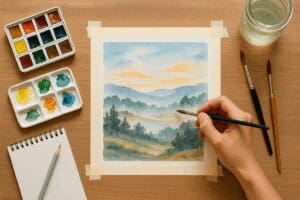Welcome to the enchanting world of oil painting! Whether you’re an absolute beginner or someone looking to refine your art skills, understanding the essential tools and materials is the first step to creating your masterpiece. In this comprehensive guide, we’ll cover everything you need to know about starting your oil painting journey, including necessary supplies such as brushes, paints, mediums, and canvases. By the end, you’ll be well-equipped to dive into your artistic endeavors with confidence.
Why Choose Oil Painting?
Oil painting has been a favored medium among artists for centuries due to its rich texture, vibrant colors, and versatility. Renowned artists like Vincent van Gogh, Leonardo da Vinci, and Rembrandt created timeless masterpieces using oil paints. The slow drying time of oil paints allows artists to work and rework the paint on the canvas, offering a wide range of techniques and styles.
Essential Supplies for Oil Painting
1. Brushes
Brushes are the artist’s primary tool, and selecting the right ones can significantly impact your painting process. Here are some types of brushes you should consider:
- Round Brushes: Ideal for detail work and thin lines.
- Flat Brushes: Great for bold strokes and filling in large areas.
- Filbert Brushes: Versatile brushes that can be used for blending, soft edges, and details.
- Fan Brushes: Perfect for blending and creating textures like foliage and clouds.
Recommended Brands: Winsor & Newton, Princeton, and Escoda.
2. Paints
Choosing high-quality oil paints is crucial for achieving vibrant and long-lasting colors. Oil paints come in two grades: artist-grade and student-grade.
- Artist-Grade Paints: These have a higher pigment concentration and better quality, providing more vibrant colors and a smoother texture.
- Student-Grade Paints: More affordable and suitable for beginners, but they have less pigment and may not be as vibrant.
Essential colors to start with include:
- Titanium White
- Ivory Black
- Ultramarine Blue
- Cadmium Red
- Cadmium Yellow
- Burnt Sienna
- Raw Umber
Recommended Brands: Winsor & Newton, Gamblin, and Rembrandt.
3. Mediums
Mediums are substances added to oil paints to alter their consistency, drying time, and finish. Common mediums include:
- Linseed Oil: Thins paint and adds gloss.
- Liquin: Speeds up drying time.
- Turpentine: Used for thinning paints and cleaning brushes.
- Galkyd: Increases the transparency and gloss of the paint.
Recommended Brands: Winsor & Newton, Gamblin, and Daler-Rowney.
4. Canvases
The canvas is your painting surface, and choosing the right type can affect your work’s durability and texture. Canvases come in various forms, such as stretched canvas, canvas boards, and canvas paper.
- Stretched Canvas: A wooden frame stretched with primed canvas, ready to use.
- Canvas Boards: Canvas mounted on a board, providing a firm surface.
- Canvas Paper: Portable and suitable for practice or studies.
Recommended Brands: Winsor & Newton, Fredrix, and Arteza.
5. Palette
A palette is essential for mixing and holding your paints. There are different types of palettes available:
- Wooden Palettes: Traditional and sturdy.
- Glass Palettes: Easy to clean and maintain.
- Disposable Palettes: Convenient for easy cleanup.
6. Easel
An easel holds your canvas at a comfortable working height and angle. Types of easels include:
- A-Frame Easels: Portable and adjustable.
- H-Frame Easels: Sturdy and ideal for larger canvases.
- Tabletop Easels: Compact and great for small spaces.
7. Other Tools
- Palette Knives: For mixing paint and applying thick layers.
- Brush Cleaner: Keeps your brushes in good condition.
- Rags and Paper Towels: For cleaning brushes and wiping away excess paint.
- Mahl Stick: A support tool to steady your hand while painting.
Setting Up Your Workspace
Creating a dedicated and organized workspace is crucial for a productive painting session. Ensure your space has good lighting, proper ventilation, and easy access to your tools. A comfortable chair and a stable easel are essential. Having a clean and organized palette area will help you mix colors efficiently.
Basic Oil Painting Techniques
1. Underpainting
Underpainting involves creating a base layer on the canvas to establish the composition and tonal values. This layer is typically done using a monochromatic palette and is left to dry before adding colors.
2. Glazing
Glazing is the process of applying thin, transparent layers of paint over a dry layer. This technique creates depth and luminosity in the painting.
3. Impasto
Impasto involves applying thick layers of paint to create texture and dimension. This technique adds a tactile quality to the artwork and emphasizes brushstrokes.
4. Blending
Blending is crucial for creating smooth transitions between colors. Use soft brushes and mediums like linseed oil to achieve seamless gradients.
5. Scumbling
Scumbling involves applying a thin, broken layer of paint over a dry layer to create a textured, soft-focus effect.
Safety Tips for Oil Painting
Oil painting involves the use of chemicals and solvents that can be hazardous if not handled properly. Here are some safety tips:
- Ventilation: Ensure your workspace is well-ventilated to avoid inhaling fumes from solvents.
- Protective Gear: Wear gloves and an apron to protect your skin and clothing.
- Proper Disposal: Dispose of rags and paper towels soaked in solvents safely to avoid fire hazards.
- Storage: Store your paints, mediums, and solvents in a cool, dry place away from direct sunlight.
Resources and Further Learning
To continue your journey and improve your skills, consider exploring these resources:
- Winsor & Newton Oil Painting Guides
- Gamblin Oil Painting Tips
- Royal Academy of Arts Online Courses
- YouTube Channel: Draw Mix Paint
Conclusion
Embarking on the journey of oil painting can be incredibly rewarding. With the right tools and materials, you can explore endless possibilities and express your creativity in unique ways. Remember to start with high-quality brushes, paints, and canvases, and take the time to experiment with different techniques and mediums. Most importantly, enjoy the process and have fun creating your own masterpieces.
For more tips, tutorials, and inspiration, follow us on social media and use the hashtags #OilPainting, #ArtForBeginners, and #ArtmartTips. Happy painting!
*For collaborations, art features, or inquiries, please contact us at [email protected]. Don’t forget to follow us on Instagram, Facebook, Twitter.
Disclaimer: The views and opinions expressed in this article do not necessarily reflect the official policy or position of Irish Artmart.



